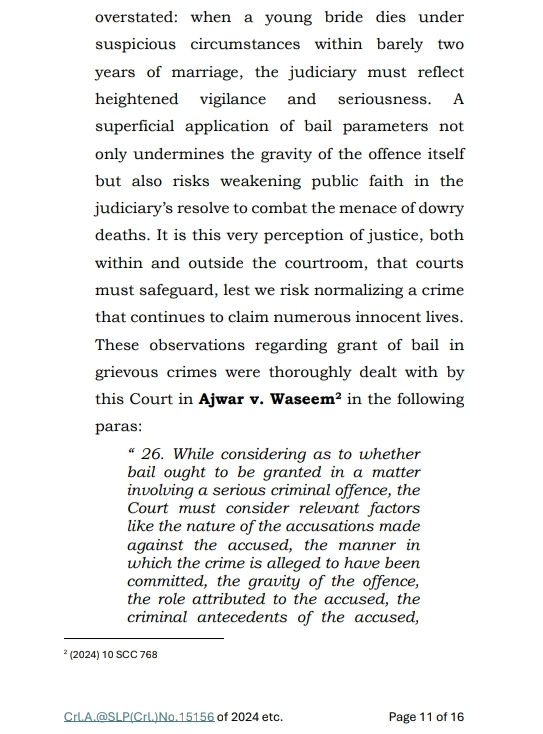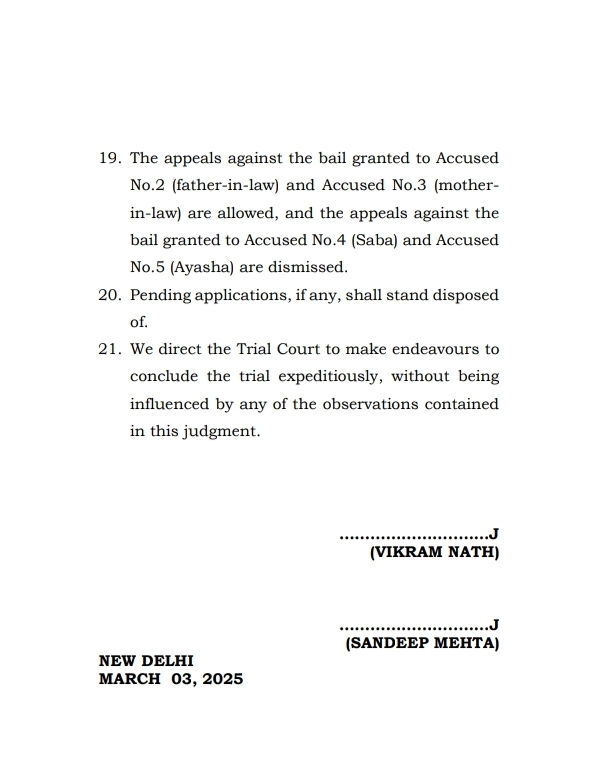Dowry Deaths: SC Decides Bail Precisely
- M.R Mishra

- Mar 5
- 3 min read
In a significant ruling on March 3, 2025, the Supreme Court of India sent a clear message about its resolve to tackle dowry-related crimes with the judgment in Shabeen Ahmad v. State of Uttar Pradesh & Anr.
This case, centered on the cancellation of bail for accused individuals in a dowry death matter, isn’t just another legal footnote—it’s a vivid reminder of the judiciary’s role in balancing individual freedom with the urgent need to protect society from deep-rooted gender violence.
“When a young bride dies under suspicious circumstances, the judiciary must reflect heightened vigilance,”
What's the Matter?
The story begins with Shahida Bano, a young bride who married Sami Khan in February 2022. What should have been a new chapter of hope quickly turned into a nightmare. Soon after the wedding, her in-laws allegedly began pressuring her for dowry—first demanding a “Bullet” motorcycle, then raising the stakes to a car. On January 22, 2024, Shahida was found dead in her matrimonial home, a dupatta tied to a ceiling fan, her body marked with multiple injuries.
The post-mortem report was unequivocal: death by “asphyxia due to strangulation,” not suicide. Her brother, Shabeen Ahmad, took up her cause, filing an FIR under laws meant to shield women from such horrors—Sections 498A (cruelty) and 304B (dowry death) of the Indian Penal Code, alongside the Dowry Prohibition Act.

The accused were Shahida’s husband, Sami Khan, and four of his family members: father-in-law Mukhtar Ahmad, mother-in-law Tara Bano, and sisters-in-law Saba and Ayasha. Initially, the Sessions Court saw the gravity of the situation—denying bail to all four based on the chilling medical evidence and the seriousness of the charges.

But the Allahabad High Court took a different view, granting bail to them all, citing factors like their clean criminal records and, for the women, their gender. That’s when the Supreme Court stepped in, unwilling to let this case slip through the cracks of judicial oversight.
What Court Said?
The Supreme Court’s ruling was surgical in its precision. For the parents-in-law, Mukhtar and Tara, bail was canceled. Why? The evidence pointed to their central role in the dowry demands and the violence inflicted on Shahida. Those ante-mortem injuries weren’t random—they painted a picture of deliberate cruelty, backed by a post-mortem that ruled out any chance of self-harm. The Court leaned on precedent, invoking cases like *Ajwar v. Waseem (2024)* to argue that when allegations scream of heinous acts tied to dowry, bail isn’t a casual handout. It’s a decision that must weigh the societal cost of letting such crimes fester unchecked.
Yet, the sisters-in-law, Saba and Ayasha, caught a different fate. Their bail stood. The Court saw their involvement as less direct—more peripheral than pivotal. Add to that their personal circumstances—Ayasha still in school, Saba newly married—and the justices opted for leniency. But make no mistake: this wasn’t a free pass. It was a measured call, recognizing their lesser role while keeping the door open for justice to run its course in trial.
What really stings in this judgment is the Supreme Court’s sharp rebuke of the High Court.
The lower court’s approach was labeled “mechanical”—a rubber-stamp decision that glossed over the evidence and the broader stakes. Dowry deaths aren’t just personal tragedies; they’re a systemic plague. By letting bail slide too easily, courts risk normalizing a crime that’s already too entrenched.
The Supreme Court demanded more—calling for “heightened vigilance” in cases where women’s lives are bartered for material gain.
So, what does this mean moving forward? For one, it’s a wake-up call to lower courts. Bail in dowry death cases can’t be a checklist exercise—ticking boxes like “no prior record” or “female accused” won’t cut it anymore.
The evidence, the allegations, the sheer weight of the crime have to take center stage. It’s also a signal to legal practitioners: if you’re arguing bail in these cases, you’d better come armed with more than platitudes.
The *prima facie* threshold under Sections 304B and 498A isn’t a suggestion—it’s a mandate.
As the trial unfolds, this judgment will linger as a benchmark, a reminder that when a young bride dies under a cloud of suspicion, the system can’t look the other way. “When a young bride dies under suspicious circumstances, the judiciary must reflect heightened vigilance,” the Court declared. And with this ruling, it’s proving those aren’t empty words.








Very good information